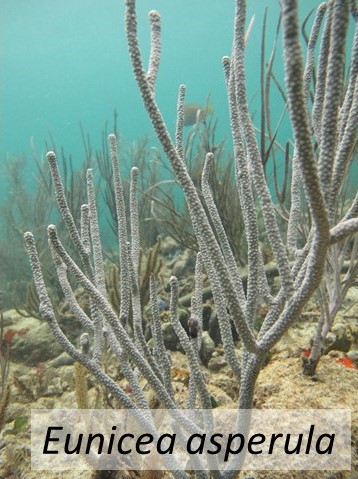
Family: Plexauridae
Common Name(s): Knobby candelabra.
Colony Form: Bushy candelabrum-like or with a few long branches; to 1 m tall.
Axis: Cylindrical, very thin at branch tips.
Branches: Thick, ascending branches; never broad or flattened, clavate; usually 5-10 mm in diameter.
Apertures: Calices with small, upturned lower lip, never tube-like, usually producing a coarse texture.
Mucus: Absent
Color: Gray to black with brown polyps. Dry specimens are deep black but with paler calices.
Sclerites: Polyp armature: long curved rods 0.45-0.55 mm long; medium rods irregularly curved (0.14-0.23 mm), small flat rods (0.05-0.12 mm), and occasionally abundant octoradiate forms in tentacles. Axial layer: strongly ornamented spindles, colorless or slightly purple, sometimes including branching processes, to 0.3 mm long. Middle layer: spindles 0.69-1.9 mm long. Surface layer: foliate clubs to 0.15 mm long.
Habitat: Leeward side of reef terraces, upper reef slopes in 10-30 m depths.
Distribution: South Florida, Gulf of Mexico, and northern Lesser Antilles. Uncommon in the southern Caribbean.
Notes: Northern specimens from Florida and the Gulf of Mexico have thinner branches than those from South America.
Similar Species: Eunicea fusca; Eunicea clavigera; Eunicea tourneforti











